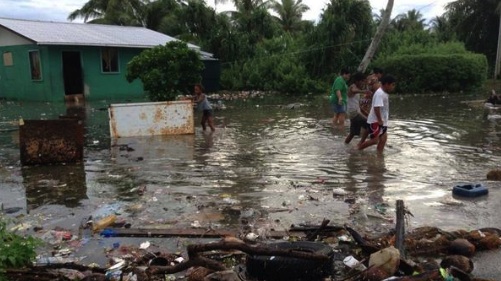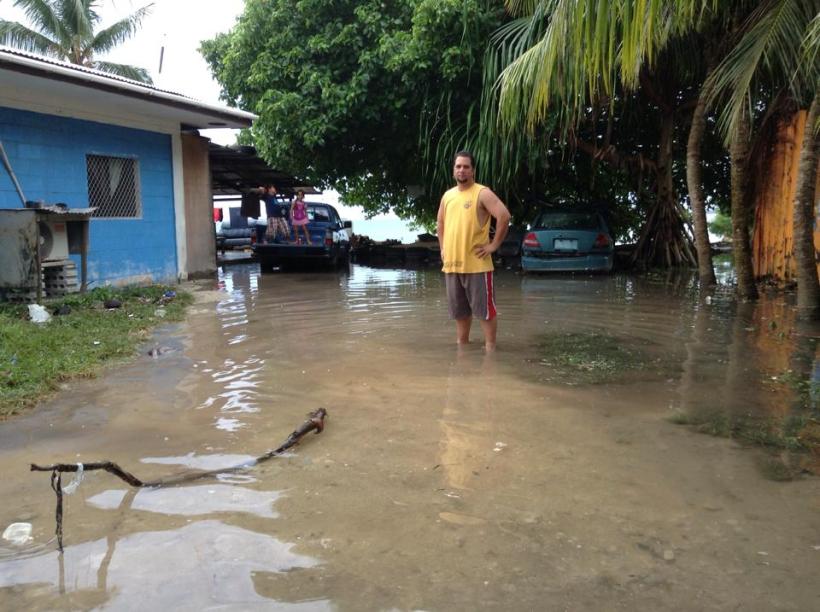
*This is an article I originally wrote for the UN-Non-Governmental Liason Services E-Magazine, three weeks after returning home from the United Nations Summit.
It has been three weeks since I spoke and performed “Dear Matafele Peinam” at the United Nations opening of the Climate Summit. Three weeks, and still I am processing the amazing whirlwind that was the few days I had spent in New York, marching with over 3,000 others at the People’s Climate March and meeting dignitaries from all over the world. Yes, for a small island girl from the Marshall Islands, the entire thing was overwhelming, amazing, and thrilling.
At the time, I had no idea what kind of reaction and response I would receive for the little poem I had written. I only knew that I wanted to write a poem that was true to my story – something my daughter could read years later, perhaps when she is my age now, and understand that we were doing more than just standing by and waiting for a change to come. That we were standing up, speaking out, and taking fate into our own hands.
After all the interviews, photos, hand-shaking, and flying thousands of miles, coming back to home to my island of Majuro, was huge a relief. My family welcomed me at the airport with signs and tshirts with my name on it, playing the ukulele and singing of how proud they were. It was their support that meant everything to me.
Unfortunately, coming home was not all ukulele songs and congratulations. It was also coming home to the stark reality of living with climate change. This past Friday, we received a warning of a significant high tide at 5 pm. What should have been a mere high tide ended up turning into swells and huge waves that engulfedseawalls, flooding and damaging homes and roads. Many families were directly affected.
As I was making my way home after a long day of teaching, I saw cars inching carefully along roads completely littered by debris, rocks, and coral. The level of debris and how far they were from the shoreline demonstrated the power of the waves. There was a quiet, hushed energy in the air, as if each of us were holding our breaths – reminded once again, of just how vulnerable we were.
At one point, I decided to take pictures of the damaged homes so I could send it out over social media. While I was taking photos, a man called me over. He stood in the pool of water that was up to his ankles in his yard. “Take a picture of our house,” he said. “Maybe this will go to the U.N.”
The scary part of this event is the fact that it happened during this time at all – it isn’t even the “King Tides” season yet. King Tides periodically occur when the sun and moon align and the moon’s orbit passes closest to the Earth. These generally occur during the winter and the summers, and are usually when the waves are the most dangerous, and when the damage is the worst. Sea level rise, however, is exacerbating both our King Tides seasons as well as our seasons of high tides.
During the last King Tides of March, my cousin’s home, which had been there for more than 20 years, was completely leveled by the water. Since then they’ve had to move from rental to rental, trying to find a home they can afford, and taking out loans to pay for a new house to be built. I’ve seen the stress and financial burden exhausting her and her father, as they struggle to make do with her paycheck as a 1st grade teacher, and his as an employee of the government.
I spoke with Reginald White, the Meteorologist in Charge from our Weather Station, about this past week’s inundation. “We have more than 50 years of sea level data and incidences. But from my experience, these wave inundations are getting so much more frequent,” he told me. “Every time there is something like a high tide, the weather station is immediately on alert. And it didn’t used to be like that.” According to Reginald, we can expect more events like the flooding from this past week in the coming months – only worse – since it will be the actual season of King Tides.
All this weekend, I’ve been wondering what are possible solutions – what can we do besides continue beating the climate-change-is-real drum until someone listens to us? What can we do for the people who are affected now? Who, like my cousins and the man in the photo, are just struggling to survive?
One way is to create a fund for those affected directly. We at the non-profit organization, Jo-Jikum, have created a climate donation fund to assist those whose homes have been damaged by climate change events such as high tides, king tides, and drought. 100 percent of these funds will be given directly to those families, to assist them and alleviate the stress and financial burden caused by these events. To donate, please visit our website at www.jojikum.org. The website is still a bit rough, under construction, but at the very least we have a place to collect funds now, so that we can be prepared for the next climate disaster.
Our politicians will continue the good fight in the global arena to have our voices heard and to create effective policies and changes. I have the utmost faith in our leaders. But this climate fund from Jo-Jikum is one tangible way to help those who are suffering right now, at this very moment. Those who are just trying to survive.
In the meantime, I will also do everything I can to continue the momentum from the Climate Summit. It was one step. A big step. But climate affects like these wave surges will only continue to get worse, and more families throughout the world will continue to struggle. Which makes the climate movement that much more important. But as I told Matafele Peinam, we are going to fight. And we are spreading the word. Because we really deserve to do more than just survive. We deserve to thrive.


November 4, 2014 at 2:40 pm
I will spread the word and bring awareness of what is the reality of climate change on the Marshall Islands.
Pingback: Meet Kathy Jetnil-Kijiner, Marshall Islands – Nobel Women's Initiative